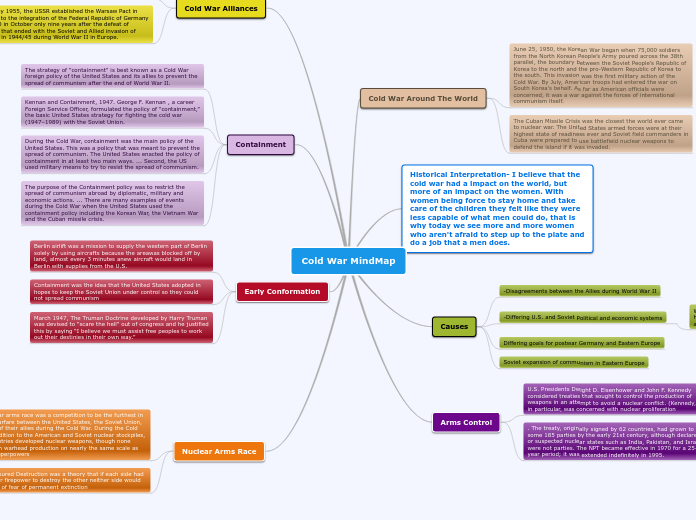
June 25, 1950, the Korean War began when 75,000 soldiers from the North Korean People’s Army poured across the 38th parallel, the boundary between the Soviet People’s Republic of Korea to the north and the pro-Western Republic of Korea to the south. This invasion was the first military action of the Cold War. By July, American troops had entered the war on South Korea’s behalf. As far as American officials were concerned, it was a war against the forces of international communism itself.
The Cuban Missile Crisis was the closest the world ever came to nuclear war. The United States armed forces were at their highest state of readiness ever and Soviet field commanders in Cuba were prepared to use battlefield nuclear weapons to defend the island if it was invaded.
-Disagreements between the Allies during World War II
-Differing U.S. and Soviet political and economic systems
Women did not really have a role on the field but rather at home Women were responsible for taking care of the children and being a homebody.
Differing goals for postwar Germany and Eastern Europe
Soviet expansion of communism in Eastern Europe
U.S. Presidents Dwight D. Eisenhower and John F. Kennedy considered treaties that sought to control the production of weapons in an attempt to avoid a nuclear conflict. (Kennedy, in particular, was concerned with nuclear proliferation
. The treaty, originally signed by 62 countries, had grown to some 185 parties by the early 21st century, although declared or suspected nuclear states such as India, Pakistan, and Israel were not parties. The NPT became effective in 1970 for a 25-year period; it was extended indefinitely in 1995.
NATO or the North Atlantic Treaty Organization consisted of the U.S.Canada and most west European countries and it was designed to counter Soviet power in Europe
On 14 May 1955, the USSR established the Warsaw Pact in response to the integration of the Federal Republic of Germany into NATO in October only nine years after the defeat of Germany that ended with the Soviet and Allied invasion of Germany in 1944/45 during World War II in Europe.
The strategy of "containment" is best known as a Cold War foreign policy of the United States and its allies to prevent the spread of communism after the end of World War II.
Kennan and Containment, 1947. George F. Kennan , a career Foreign Service Officer, formulated the policy of “containment,” the basic United States strategy for fighting the cold war (1947–1989) with the Soviet Union.
During the Cold War, containment was the main policy of the United States. This was a policy that was meant to prevent the spread of communism. The United States enacted the policy of containment in at least two main ways. ... Second, the US used military means to try to resist the spread of communism.
The purpose of the Containment policy was to restrict the spread of communism abroad by diplomatic, military and economic actions. ... There are many examples of events during the Cold War when the United States used the containment policy including the Korean War, the Vietnam War and the Cuban missile crisis.
Berlin airlift was a mission to supply the western part of Berlin solely by using aircrafts because the areawas blocked off by land, almost every 3 minutes anew aircraft would land in Berlin with supplies from the U.S.
Containment was the idea that the United States adopted in hopes to keep the Soviet Union under control so they could not spread communism
March 1947, The Truman Doctrine developed by Harry Truman was devised to "scare the hell" out of congress and he justified this by saying “I believe we must assist free peoples to work out their destinies in their own way.”
The nuclear arms race was a competition to be the furthest in nuclear warfare between the United States, the Soviet Union, and both of their allies during the Cold War. During the Cold War, in addition to the American and Soviet nuclear stockpiles, other countries developed nuclear weapons, though none engaged in warhead production on nearly the same scale as the two superpowers
Mutual Assured Destruction was a theory that if each side had the nuclear firepower to destroy the other neither side would attack out of fear of permanent extinction